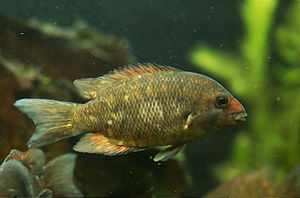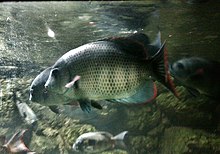Paretroplus
| Paretroplus | ||||||||||||
|---|---|---|---|---|---|---|---|---|---|---|---|---|

|
||||||||||||
| Systematics | ||||||||||||
|
||||||||||||
| Scientific name | ||||||||||||
| Paretroplus | ||||||||||||
| Bleeker , 1868 |
Paretroplus ( Syn .: Lamena Allgayer, 1998 ) is a genus of cichlids thatis endemic to Madagascar . Two species live in fresh waters of the eastern coastal plain, while the others are only found in lakes and rivers in northwest Madagascar. The genus name refers to the close relationship to the South Indian cichlid genus Etroplus .
features
Paretroplus species become 15 to 40 cm long. Their body is moderately to very high back, the snout pointed, the mouth terminal or slightly below. In general, species that live in flowing waters are slimmer, while those that live in stagnant waters are very high back. The Paretroplus species differ from all other cichlid species found in Madagascar in the individual row of teeth in each jaw, the scaling only in smooth-edged round scales and the numerous anal fin spines (7 to 11). The jaw teeth are not numerous, single-pointed, spade-shaped and set far apart. The ones lying in front, especially those on the intermaxillary bone (premaxillary), are larger than those lying further back. The bases of the dorsal and anal fin are enclosed by scale pockets into which the fins can partially be placed. The caudal fin closes straight or is indented. Adult specimens of most species show distinct vertical stripes on the sides of the body.
Way of life
Paretroplus species live in fresh waters up to 300 m above sea level , some species also in brackish water . They are omnivores and feed mainly on snails , freshwater shrimp and other aquatic invertebrates and all kinds of plant material. They are monogamous substrate spawners and form a parent family . Species that live in fast-flowing waters such as Paretroplus nourissati and Paretroplus tsimoly spawn in caves, the others on open rock surfaces or on sunken wood. The clutch rarely includes up to 500 pink, beige or olive colored eggs. The breeding territory is defended long after the juveniles have been swimming free. Aquarium offspring reach sexual maturity at an age of 18 to 24 months, the fish reach their final size at an age of three to five years.
species
Currently (2012) there are 13 species described . In addition, two other, previously undescribed species are known:
- Paretroplus dambabe Sparks, 2002
- Paretroplus damii Bleeker, 1868
- Paretroplus gymnopreopercularis Sparks, 2008
- Paretroplus kieneri Arnoult, 1960
- Paretroplus lamenabe Sparks, 2008
- Paretroplus loisellei Sparks & Schelly, 2011
- Paretroplus maculatus Kiener & Maugé, 1966 , lower reaches of the Betsiboka .
- Paretroplus maromandia Sparks & Reinthal, 1999
- Paretroplus menarambo Allgayer, 1996
- Paretroplus nourissati (Allgayer, 1998)
- Paretroplus petiti Pellegrin, 1929
- Paretroplus polyactis Bleeker, 1878
- Paretroplus tsimoly Stiassny, Chakrabarty & Loiselle, 2001
External system
In contrast to all other Malagasy genus of cichlids, the genus Paretroplus does not belong to the subfamily Ptychochrominae , but rather forms the subfamily Etroplinae together with the Indian genus Etroplus , which is at the base of the cichlid tree.
Danger

Most Paretroplus species are endangered by overfishing, increasing biotope destruction, the importation of foreign fish species such as tilapia , largemouth bass , giant gouramis , carp , gambus and guppies , which compete with the cichlids for food or eat their young . P. menarambo is already extinct in the wild and is only preserved by aquarium breeding . P. maculatus is on the verge of extinction. Various institutions are trying to save the Malagasy cichlids from extinction through conservation breeding.
literature
- PV Loiselle and P. de Rham: Paretroplus, Damba , pages 877-878 in Steven M. Goodman, Jonathan P. Benstead, Harald Schütz: The Natural History of Madagascar , University of Chicago Press, ISBN 0-226-30307-1
Web links
- Paretroplus on Fishbase.org (English)
